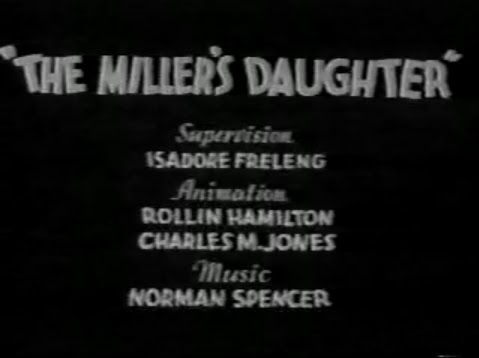The Millers Daughter (1934 film)
4.8 /10 1 Votes4.8
Film series Merrie Melodies People also search for Rhythm In The Bow Country United States | 4.6/10 IMDb Genre Family, Animation, Short Duration Language English | |||||||||||||||||||||||||||||||||
 | ||||||||||||||||||||||||||||||||||
Release date October 13, 1934 (1934-10-13) Production Warner Bros. Entertainment Genres Animation, Short Film, Comedy, Family film | ||||||||||||||||||||||||||||||||||
The Miller's Daughter is a 1934 American animated short film by Friz Freleng, his seventh in the Merrie Melodies series.
Contents
Plot
A cat trying to eat a caged bird knocks over a ceramic figurine of a young girl, breaking it. A woman gathers the pieces and puts them in a bin in the attic. The matching boy figurine comes to life, and he and his lamb go to rescue their companion. After he glues her back together, they dance to a medley including "The Miller's Daughter" by Lou Handman and Al Bryan, a Cuban instrumental, and the Blue Danube Waltz. After a lion figurine comes to life and tries to eat the lamb, they escape back downstairs, breaking a table lamp in the process. The cat gets blamed by the woman for the broken lamp.
Production
According to animation historian Michael Barrier, the film is among the first Merrie Melodies short films directed by then-new director Friz Freleng. It was only his 7th film for the series. Freleng became the main director of this series in early 1934. Barrier found that some of the earliest films directed by Freleng came "surprisingly close" to the contemporary Disney animated shorts in both spirit and execution. The Miller's Daughter in particular was "rich in production values". Barrier finds that the "painstaking" drawing of the film, its modeling, and the use of rotoscoping for the movement to attest to the effort devoted to its production. It was an improvement over previous Merrie Melodies films.
The drawing of the film was "Disneyish", but Barrier finds that the subject matter (china figurines coming to life) is reminiscent of an actual Disney short. The film is similar to The China Shop, released by Disney as part of the Silly Symphonies earlier that year. The film was one of the few Freleng-directed films that came close to matching the Silly Symphonies on their own terms. However, competing with Disney turned out to be too difficult and expensive. The production budgets for the animated films of Leon Schlesinger Productions (the company later known as Warner Bros. Cartoons) were lower than their counterparts for Walt Disney Productions. The directors of the Schlesinger studio also completed animated short films at a faster pace than the Disney directors. A new Schlesinger film was ready for release every four or five weeks. Any extra time that Freleng devoted to the production of a single film, would come at the cost of cutting corners in the production of another one.
The Miller's Daughter is a black and white film, one of the last Merrie Melodies released in black and white. In April 1934, the first Merrie Melodies film directed by Freleng was released. It was Beauty and the Beast, a color film using a two-color process. However, the next six films directed by Freleng (including The Miller's Daughter) were all in black and white. A new release season started in November 1934, with the release of Those Beautiful Dames in color. From then on, all Merrie Melodies were color films. Meanwhile the sibling Looney Tunes series continued to be released in black and white. Barrier notes that the change in color came with an increase in payments made from Warner Bros. to producer Leon Schlesinger. Warner Bros. made a payment of 1,750 dollars for each black-and-white Merrie Melodies film. It made a payment of 9,250 dollars for the color films of the series. Despite an increase in the production budget of the series, the Schlesinger budgets continued to be smaller than the Disney ones. According to Barrier, the switch to color did not translate to "greater refinement" for the Merrie Melodies under the direction of Freleng.
References
The Miller's Daughter (1934 film) WikipediaThe Millers Daughter (1934 film) IMDb The Millers Daughter (1934 film) themoviedb.org
